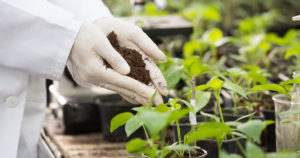By Fred Nichols
Chief Marketing Officer,
Bio Huma Netics, Inc.
 Farmers love to grow corn. Only twice in modern history has corn not held the title of the most-grown crop in the USA. That was in 2018 and (if you count it) 1983, when the government’s PIK program artificially swayed planting practices. Spurred by record fertilizer prices, many projected soybeans would overtake corn last year in their annual acreage tug-of-war. But the allure of maize once again prevailed. [Read more…]
Farmers love to grow corn. Only twice in modern history has corn not held the title of the most-grown crop in the USA. That was in 2018 and (if you count it) 1983, when the government’s PIK program artificially swayed planting practices. Spurred by record fertilizer prices, many projected soybeans would overtake corn last year in their annual acreage tug-of-war. But the allure of maize once again prevailed. [Read more…]
 In a research study, originally published in Frontiers in Plant Science, May 2021, Vol. 12:660224, the biostimulant properties of humic acids (HA) were tested on Micro Tom tomato plants under increasing nutritional stress. The results confirmed the positive role humic acids play in enhancing nutrient efficiency uptake in plants.
In a research study, originally published in Frontiers in Plant Science, May 2021, Vol. 12:660224, the biostimulant properties of humic acids (HA) were tested on Micro Tom tomato plants under increasing nutritional stress. The results confirmed the positive role humic acids play in enhancing nutrient efficiency uptake in plants. We are accustomed to seeing humic substances (humic and fulvic) in dry/granular form, and we tend to think of acids as liquids. So why are humic and fulvic substances called acids?All substances, solid AND liquid, have a chemical makeup. An acid is a chemical that can donate a proton (H+) to a water molecule (H2O, which would form H3O+) or to another chemical such as ammonia (NH3, which would form NH4+).
We are accustomed to seeing humic substances (humic and fulvic) in dry/granular form, and we tend to think of acids as liquids. So why are humic and fulvic substances called acids?All substances, solid AND liquid, have a chemical makeup. An acid is a chemical that can donate a proton (H+) to a water molecule (H2O, which would form H3O+) or to another chemical such as ammonia (NH3, which would form NH4+). y 2021 issue, Frontiers in Plant Science published a research article by BHN Humic R&D Lab scientists Dr. Hiarhi Monda, Ryan Fountain, and Dr. Richard T. Lamar in collaboration with Dr. Amy McKenna of the National High Magnetic Field Laboratory, Ion Cyclotron Resonance Facility, Tallahassee, Fla.
y 2021 issue, Frontiers in Plant Science published a research article by BHN Humic R&D Lab scientists Dr. Hiarhi Monda, Ryan Fountain, and Dr. Richard T. Lamar in collaboration with Dr. Amy McKenna of the National High Magnetic Field Laboratory, Ion Cyclotron Resonance Facility, Tallahassee, Fla.